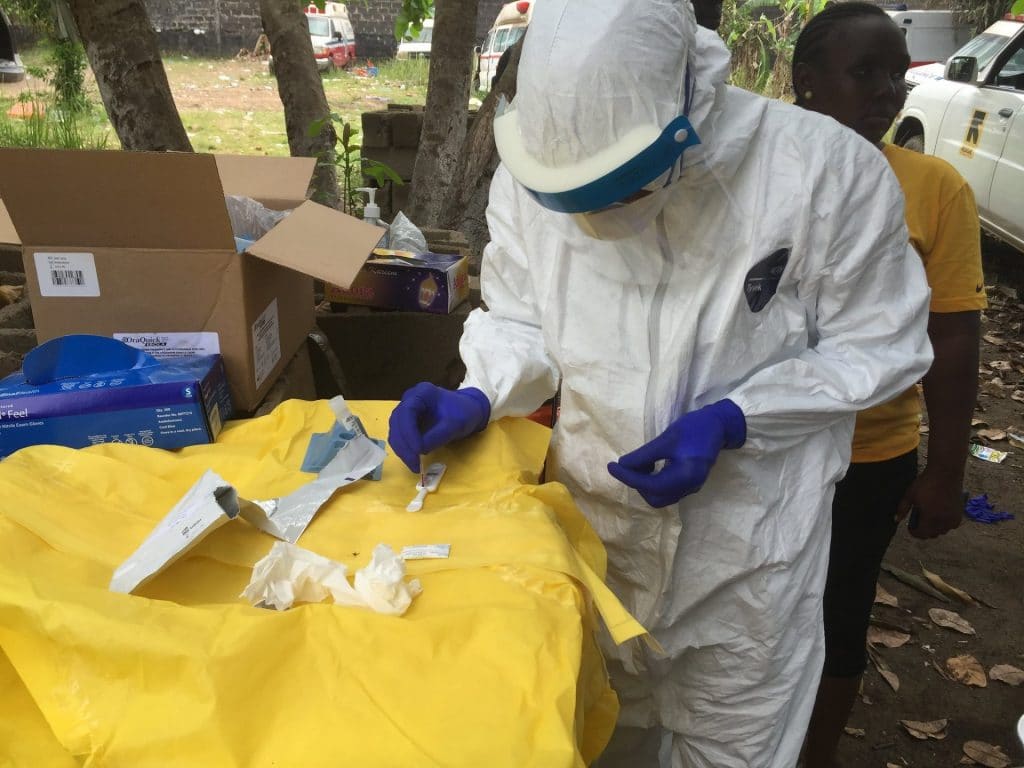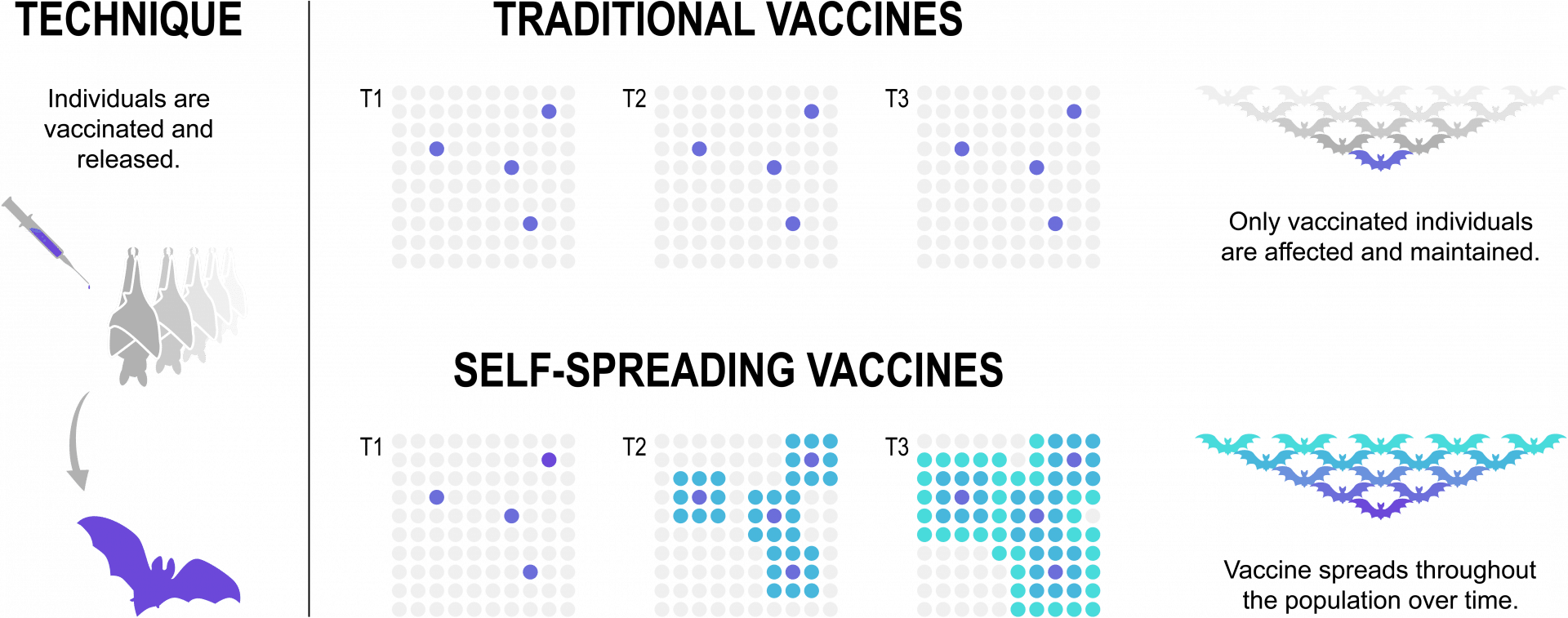Scientists are working on vaccines that spread like a disease. What could possibly go wrong?
Thu 8:36 am +01:00, 6 May 2021
Once a COVID-19 vaccine is approved for public use, officials around the world will face the monumental challenge of vaccinating billions of people, a logistical operation rife with thorny ethical questions. What if instead of orchestrating complicated and resource-intensive campaigns to vaccinate humans against emerging infectious diseases like COVID-19, we could instead stop the zoonotic diseases that sometimes leap from animals to people at their source? A small, but growing number of scientists think it’s possible to exploit the self-propagating properties of viruses and use them to spread immunity instead of disease. Can we beat viruses like SARS-CoV-2, the novel coronavirus, at their own game?
A virus that confers immunity throughout an animal population as it spreads in the wild could theoretically stop a zoonotic spillover event from happening, snuffing out the spark that could ignite the next pandemic. If the wild rats that host the deadly Lassa virus, for example, are vaccinated, the risks of a future outbreak among humans could be reduced. For at least 20 years, scientists have been experimenting with such self-spreading vaccines, work that continues to this day, and which has gained the attention of the US military.
For obvious reasons, public and scientific interest in vaccines is incredibly high, including in self-spreading vaccines, as they could be effective against zoonotic threats. The biologists Scott Nuismer and James Bull generated fresh media attention to self-spreading vaccines over the summer after publishing an article in the journal Nature Ecology & Evolution. But the subsequent reporting on the topic gives short shrift to the potentially significant downsides to releasing self-spreading vaccines into the environment.
Self-spreading vaccines could indeed entail serious risks, and the prospect of using them raises challenging questions.
Who decides, for instance, where and when a vaccine should be released? Once released, scientists will no longer be in control of the virus. It could mutate, as viruses naturally do. It may jump species. It will cross borders. There will be unexpected outcomes and unintended consequences. There always are.
While it may turn out to be technically feasible to fight emerging infectious diseases like COVID-19, AIDS, Ebola, and Zika with self-spreading viruses, and while the benefits may be significant, how does one weigh those benefits against what may be even greater risks?
How they work. Self-spreading vaccines are essentially genetically engineered viruses designed to move through populations in the same way as infectious diseases, but rather than causing disease, they confer protection. Built on the chassis of a benign virus, the vaccines have genetic material from a pathogen added to them that stimulates the creation of antibodies or white blood cells in “infected” hosts.
These vaccines could be particularly useful, some scientists say, for wildlife populations where direct vaccination is difficult due to issues like inaccessible habitats, poor infrastructure, high costs, or lack of resources. The idea, essentially, is to vaccinate a small proportion of a population through direct inoculation. These so-called founders will then passively spread the vaccine to other animals they encounter either by touch, sex, nursing, or breathing the same air. Gradually, these interactions could build up population-level immunity.

Self-spreading vaccines have some of their roots in efforts to reduce pest populations. Australian researchers described a virally spread immunocontraception, which hijacked the immune systems of infected animals—in this case a non-native mouse species in Australia—and prevented them from fertilizing offspring. The earliest self-spreading vaccine efforts targeted two highly lethal infectious diseases in the European rabbit population (myxoma virus and rabbit hemorrhagic disease virus). In 2001, Spanish researchers field-tested a vaccine in a wild rabbit population living on Isla del Aire, a small Spanish island just off Menorca. The vaccine spread to more than half the 300 rabbits on the island, and the trial was deemed a success.
In 2015, another team of researchers speculated on the development of a self-spreading vaccine for the Ebola virus that could be used on wild great apes like chimpanzees. Since then, scientists have come to see a wide array of animals—from wildlife such as bats, birds, and foxes to domesticated animals like dogs, pigs, and sheep—as amenable to self-spreading vaccines.
So far, researchers have not developed experimental self-spreading vaccines for humans; there is no clear evidence that anybody is actively working on the technology. Nuismer and Bull argue, rather, that self-spreading vaccines present a revolutionary approach to control emerging infectious diseases before they even spill over from animals into the human population.
Zoonotic spillover is certainly a pressing problem; alongside SARS-CoV-2, HIV, Ebola virus, and the Zika virus, there are over a thousand other new viruses with zoonotic potential that have been detected in wild animals over the last decade. Prevention is better than a cure, Nuismer and Bull say in a New Scientist article. In their Nature Ecology & Evolution article, they claim they are “poised to begin developing self-disseminating vaccines to target a wide range of human pathogens” in animals.
Outside of an experiment, scientists would face massive technical and practical hurdles in identifying the most appropriate targets for intervention and ensuring immunity is maintained in the wildlife populations. Despite these substantial challenges, the potential security implications of self-spreading vaccines are even more serious.
The principal security concern is that of dual-use. In essence, this means that the same research that is used to develop self-spreading vaccines to prevent disease, could also be used to deliberately cause harm. You could, for instance, engineer triggers into a virus that cause immune system failures in infected people or animals, a bit like HIV does naturally. Or you could create triggers in a virus that cause a harmful autoimmune response, where the body starts attacking its own healthy cells and tissues.
The bioweapon question. While researchers may intend to make self-spreading vaccines, others could repurpose their science and develop biological weapons. Such a self-spreading weapon may prove uncontrollable and irreversible.
We don’t have to dig very deep for a historical example of weaponized biology. As the apartheid-era South African biowarfare program shows, social, political, and scientific pressures can lead to the misuse of biological innovation.
Codenamed Project Coast, South Africa’s program was primarily focused on covert assassination weapons for use against individuals deemed a threat to the racist apartheid government. In addition to producing contraptions to inject poisons, Project Coast researchers developed techniques to lace sugar cubes with salmonella and cigarettes with Bacillus anthracis.
While there have been many biowarfare programs, including several that were far more elaborate and sophisticated, the South African program is particularly relevant in thinking through malicious uses of self-spreading vaccines. One of Project Coast’s research projects aimed at developing a human anti-fertility vaccine.
The idea took hold during a time of widespread concern over worldwide population explosion. Schalk Van Rensburg, who oversaw fertility-related work at a Project Coast laboratory, told South Africa’s post-apartheid Truth and Reconciliation Commission, a forum for examining the sordid history of the era and laying the foundation for future peace and tolerance, that he thought the project was in line with the World Health Organization’s attempts to curb rising global birth rates. He believed it could bring his lab international acclaim and funding. According to Van Rensburg, Wouter Basson, the director of the biowarfare program, said the military needed an anti-fertility vaccine so that female soldiers would not fall pregnant.
While some of the scientists involved in the project denied awareness of ulterior intentions or even that their fertility work was part of a military endeavor, Van Rensburg and Daniel Goosen, a lab director, told the Truth and Reconciliation Commission that the real intention behind the project was to selectively administer the contraceptive in secret to unwitting Black South African women.
In the end, the anti-fertility vaccine was not produced before Project Coast was officially closed down in 1995, 12 years after it was initiated. An early version was tested in baboons, but never in humans. South Africa isn’t the only country to try and forcibly sterilize parts of its population. European countries, including Sweden and Switzerland, sterilized members of the Roma minority in the early half of the 20th century and some, like Slovakia, continued even beyond that. More recently, analysts have alleged that the Chinese government is sterilizing women in Xinjiang, a province with a large population of Uighur Muslims.
It doesn’t take a massive leap of the imagination to see how the aims of South Africa’s anti-fertility vaccine project would have benefited from research into self-spreading vaccines, particularly if you combine it with current developments in pharmacogenomics, drug development, and personalized medicine. Taken together, these strands of research could help enable ultra-targeted biological warfare.
An expanding potential for abuse. The Biological Weapons Convention, the treaty that bans biological weapons, is nearly 50 years old. Negotiated and agreed to in the depths of the Cold War, the convention suffers from outdated modes of operation. There are also significant compliance assessment challenges. The convention certainly didn’t stop South Africa from pursuing Project Coast in the early 1980s.
Self-spreading vaccine research is a small but growing field. At the moment, about 10 institutions are doing significant work in the area. These laboratories are primarily located in the United States, but some are in Europe and Australia, as well. As the field expands, so does the potential for abuse.
So far research has primarily been bankrolled by US government science and health funders like the National Science Foundation, the National Institutes of Health, and the Department of Health and Human Services. Private organizations like the Gates Foundation and academic institutions have also financed projects. Recently, the Defense Advanced Research Projects Agency (DARPA), sometimes thought of as the US military’s research and development wing, has gotten involved in the research. The University of California, Davis, for example, is working on a DARPA administered project called Prediction of Spillover Potential and Interventional En Masse Animal Vaccination to Prevent Emerging Pathogen Threats in Current and Future Zones of US Military Operation. According to a pamphlet, the project is “creating the world’s first prototype of a self-disseminating vaccine designed to induce a high level of herd immunity (wildlife population level protection) against Lassa virus … and Ebola.”
Military investment in biological innovation for defensive or protective purposes is permissible under the Biological Weapons Convention, but it can still send the wrong signals. It could cause countries to doubt one another’s intentions and lead to tit-for-tat investment in potentially risky research, including in self-spreading vaccines. The result of research gone awry or biowarfare could be catastrophic for health and the environment.
At a time when the norm against chemical weapons is degrading, underscored most recently by the poisoning of Russian opposition leader Alexei Navalny with the nerve agent Novichok—a crime for which many European officials blame Russia—the international community simply can’t afford to have the same thing happen to the norm against the use of biological weapons. It would completely defy the spirit of the treaty if it seemed like states would even want to pursue high-risk dual use activities in biology.
Early, open, good-faith conversations about scientific aims and advances that cause particular dual-use concerns, as self-spreading vaccines do, are essential to exploring the broader stakes of certain technical trajectories. The University of California, Davis program is pursuing ways to incorporate an “off switch” to safely control the technology. And DARPA says any field experimentation related to the project would follow biosafety protocols. But these pledges won’t suffice. Our ambition must be to make a collective decision about the technical pathways we are willing, or not willing, to take as a society.
Scientists are working on vaccines that spread like a disease. What could possibly go wrong?










